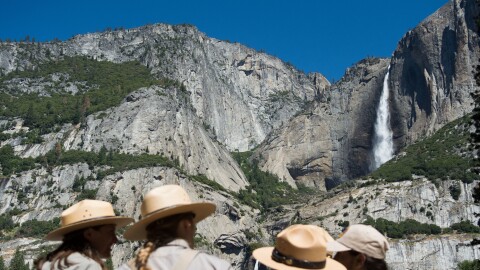Bret Ruby trudges up a slight rise at the , one of six sites that make up the Hopewell Culture National Historical Park. Ruby serves as Hopewell’s archaeologist, and he wears the dark green uniform and flat brimmed hat of the National Park Service.
To the left of Ruby is a broad stubbled tract that looks like a field left fallow. Beyond that, a long stretch of grass, bright green in the afternoon drizzle.
Today it looks like an open pasture, but Ruby explains that a couple thousand years ago, there were massive structures here. He points to a line of small yellow flags stippling the width of the field.
“Those are on the southeastern corner, and they stretch along all the way about 1,000 feet—900 or 1,000 feet—down to that corner and then they turn north,” Ruby says.
Looking down at Ruby’s map, I ask if we’re looking at the base of a large square structure.
“Yeah, we’re looking at that southern wall,” Ruby says. “We’re pretty much looking at it head-on from here.”
Hopeton lies just outside Chilicothe, and Ruby is leading a dozen or so archaeologists and environmentalists through the site to raise awareness for the . The federal program was instrumental in preserving this site, but without Congressional action, it will expire

Martin McAllister from the Nature Conservancy explains the fund money doesn’t come from taxes.
“When leases are issued for offshore oil and gas drilling, that generates money for the federal government and a small percentage of that, I believe about 11 percent, is set aside for LWCF—up to a maximum of $900 [million]—but that still has to be appropriated for spending by Congress,” McAllister says.
But according to the Department of the Interior, lawmakers have maxed out the fund only once in its 54-year existence. Some of the money goes to nationally recognized parks like the Grand Tetons in Wyoming or the Everglades in Florida, but some of the money provides matching funds for state projects.
Tom Cassidy from the National Trust for Historic Preservation says the fund had a significant impact in Ohio, protecting places like the and
“Here in Ohio, overall, the Land and Water Conservation Fund has invested more than $330 million in projects at national parks, historic sites, wildlife refuges, forests and state and local parks,” Cassidy says.
Of that pool, $3 million went to acquiring sites within the .

Jen Aultman, who works with the Ohio History Center, is pushing a UNESCO world heritage designation for the Hopewell sites. She explains the scale of a site like Hopeton is vast in size, but also in cultural significance. Who exactly built the earthworks and for what remains a mystery, but the archaeological record contains a laundry list of far flung artifacts.
Aultman says researchers have been able to identify obsidian that originated in what's now Yellowstone.
“How and why did people get obsidian from Yellowstone to Ross County?” Aultman asks. “You have shell from the Gulf Coast, you have copper from the northern Great Lakes, you have mica from the Appalachian Mountains. So the question always has been, 'Are these trade networks or in fact were people coming here because this was the important ceremonial center?'”
From up on the rise, the geometry of Hopeton Earthworks becomes a little easier to make out. Ruby explains the square’s walls stood 12 feet high and 50 feet wide at the base, with gates aligned with celestial events like solstices.
At the far edge of the square stood a circular structure traced out in massive timbers, forming a kind of woodhenge more than 1,000 feet in diameter. They can tell all this thanks to magnetic imaging, which can detect subtle differences below the soil’s surface.

Now, the most noticeable remnant to the naked eye is a raised berm off in the middle distance.
“So you’re looking—that tall piece there is this little shoulder, that little wall segment," Ruby says. "And it just happened there was a fence line was built on that, and for many years it wasn’t plowed. And so that’s the best preserved piece."
The construction of the Hopeton Earthworks was intentional, but when it comes to preservation, the whole thing can feel like a series of lucky breaks. In the mid-1800s, archaeologists could already point to agriculture’s role in reducing the structures. Those impacts grew with advent of industrial farming equipment.
It wasn’t until the 1980s that conservationists acquired the Hopewell sites, something they couldn't have done without the Land and Water Conservation Fund.
All told, the fund supported projects in every county in every state in the country, to the tune of almost $4 billion. If it isn’t reauthorized by Congress, the program expires September 30, 2018.






